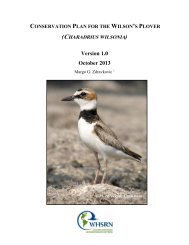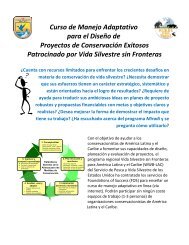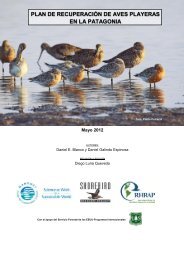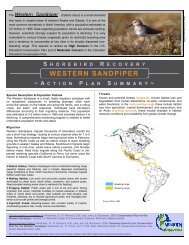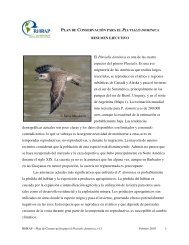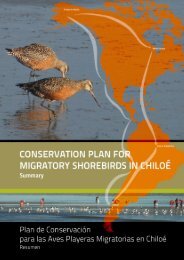Sanderling Plan - Western Hemisphere Shorebird Reserve Network
Sanderling Plan - Western Hemisphere Shorebird Reserve Network
Sanderling Plan - Western Hemisphere Shorebird Reserve Network
You also want an ePaper? Increase the reach of your titles
YUMPU automatically turns print PDFs into web optimized ePapers that Google loves.
the Central flyway, moving up the Texas Gulf coast and across the prairies (Myers et al. 1984a,<br />
1985, 1990; Castro and Myers 1987).<br />
Eastern. Most of the birds wintering along the Atlantic coast of South America, as well as<br />
a small portion of those from the Pacific coast, use this eastern flyway. During spring,<br />
<strong>Sanderling</strong>s migrate relatively quickly up the Florida Atlantic coast (their timing differs on the<br />
Florida Gulf coast) and the Carolinas during mid-March to early April. Birds stage at Delaware<br />
Bay (New Jersey) and pass through Massachusetts during May and early June. Spring peak<br />
numbers occur in mid- to late May. The most important stopover site on this flyway is Delaware<br />
Bay, where <strong>Sanderling</strong>s feast on Horseshoe Crab eggs during a brief 2-week window.<br />
MAJOR HABITATS<br />
Breeding<br />
<strong>Sanderling</strong>s nest in the high arctic on coastal tundra, peninsulas, and islands, where<br />
precipitation is less than 2.5 cm/year (Cramp and Simmons 1983). Characteristics of typical<br />
nesting areas range from well-vegetated moist sites, to gravel slopes or dry flats with sparse to no<br />
vegetation. Most nests are found on stony ridge tops, gentle slopes, and/or level alluvial plains,<br />
often within 0.5 kilometers of wet tundra, ponds, and/or lakes (MacWhirter et al. 2002).<br />
Migration<br />
During the nonbreeding season throughout its extensive range, this species occurs<br />
predominantly on sandy ocean beaches. Favored sites include hard-packed sandy beaches, but<br />
<strong>Sanderling</strong>s also use tidal mudflats (especially those with a moderate sand component), and<br />
rocky coastlines. Otherwise, on migration through the Canadian Prairies region (mainly in<br />
spring), <strong>Sanderling</strong>s use sandy beaches along shallow, saline or alkaline lakes/wetlands;<br />
elsewhere, they occur along margins of lakes, ponds, streams, and reservoirs (Godfrey 1986,<br />
Andrews and Righter 1992, Dickson and Duncan 1993). <strong>Sanderling</strong>s roost mainly on sand or<br />
cobble beaches above the wave-splash zone, or (less often) on slightly elevated sites, such as<br />
salt-marsh hummocks (MacWhirter et al. 2002). In Chaplin Lake, Saskatchewan, <strong>Sanderling</strong>s<br />
regularly roost on dikes associated with a Sodium sulphate mining operation (G. Beyersbergen<br />
pers. comm) (Note: Sodium sulphate is mainly used for the manufacture of detergents and paper<br />
pulping).<br />
WHSRN – <strong>Sanderling</strong> Conservation <strong>Plan</strong>, February 2010, v1.1 21





